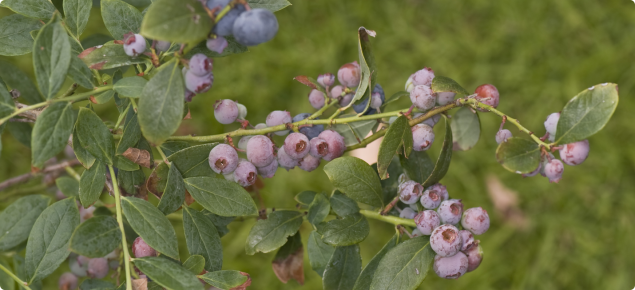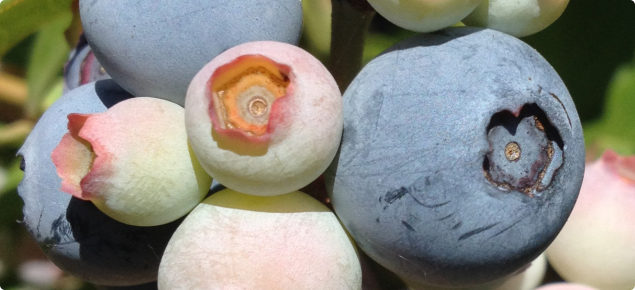Planning a blueberry orchard
Blueberry plants
Blueberry plants are available from commercial nurseries and will have been propagated from hardwood cuttings.
Varieties grown in Australia are classified into Southern Highbush, Rabbiteye and Northern Highbush.
- Southern Highbush varieties (Vaccinium corymbosum hybrid) are low-chill, requiring from 250–600 chilling hours below 7°C to induce flowering. Similar conditions are experienced near Perth. They are frost tender, mainly evergreen and adapted to warmer and drier conditions than Rabbiteye varieties. The best varieties are O’Neal, Sharpeblue and Misty, which are vigorous, early maturing and have large fruit. Biloxi and Legacy are also suitable. These varieties grow 2–3m tall.
- Rabbiteye blueberries (Vaccinium ashei) need 450–600 chilling hours below 7°C to induce flowering and are suited to cool, but frost-free locations. They are generally grown from Perth southwards, including Manjimup and Albany. Varieties include Brightwell, Premier, Powder Blue and Tifblue. Compared with Southern Highbush varieties, the fruit is smaller, darker and later maturing.
- Northern Highbush (Vaccinium corymbosum) varieties need more than 800 chilling hours below 7°C. They are frost tolerant, but due to their high chilling requirement, there are few areas in Western Australia where these varieties can be grown successfully.
Sites and soils
Blueberries grow best in light, well-drained acid soil with a pH of 4.8 to 5.5 (in water). A deep loam or sandy loam with high organic matter is best.
They can also be grown in pots using a high quality potting mix. They require high soil moisture (not waterlogged), but should have at least 450mm of well drained soil above the watertable. This may require mounding 250mm high with some slope to the site to aid drainage, ensuring excess water is diverted away from the plants.
Use of polythene mulch, weed-mat or natural mulch can reduce water loss and weed problems. The whole area may need to be covered with netting to control birds.
Managing a blueberry orchard
Planting
Prepare the site by spreading about 1t/ha of superphosphate copper zinc mix and cultivate in. Rip tree rows before planting. Good quality compost at 10 litres per hole can be applied and worked into the planting hole of young trees, especially trees which are to be grown organically.
The best time to plant is in the cooler months, especially April, May and September. Rows running north to south are preferred as they can take maximum advantage of the sun. Space rows 3–4m apart with 1.2–1.4m between plants for Rabbiteye varieties and 0.8–1.0m apart for Southern Highbush varieties.
Mulching around the young trees with coarse compost is beneficial to protect the blueberry's fine shallow root system, especially on sandy soils. Maintain this for at least the first two years after planting.
Fertilisers
Apply complete NPK fertiliser blends (containing 12–15% nitrogen, 2–5% phosphorus, 14–17% potassium, magnesium, calcium, sulphur and trace elements) at 60 grams per application per plant for young plants in early spring, and another in early summer. Increase the rates as plants grow.
Feed mature plants 150g each of the complete fertiliser in early spring, followed by a side dressing of 130g of ammonium sulphate and 100g of potassium sulphate at intervals of five or six weeks until the middle of summer.
Distribute the fertiliser evenly around the base of the plant, avoiding the stem and leaves and water in to avoid burning the plant. Ammonium sulphate and potassium sulphate can be applied through the irrigation system.
Use of fertigation through drip irrigation system is also an effective way to fertilise plants. Contact consultants on setting up such a system.
Examine leaves for deficiency symptoms during the spring–summer growth phase and conduct an annual leaf nutrient test for correct nutrient levels. Collect the first fully mature leaf (about five or six leaves from the tip) for analysis in January. Adequate levels of nitrogen and potassium in the leaves are 1.5–2.0% and 0.8–1.5% respectively.
Sodium and chloride levels higher than 0.2% and 0.5% respectively indicate toxic levels in the soil and/or water supplies.
Nitrogen is the most important nutrient, but do not over-fertilise, as this encourages vegetative growth and suppresses flowering and fruit set. Nitrogen deficiency is seen as yellow leaves and small fruit.
Potassium deficiency is less common and shows as a tip-burn on the leaves.
Magnesium deficiency can be seen as yellow areas between the green veins. If this appears, apply magnesium sulphate at 50–100kg/ha.
Boron deficiency is sometimes a problem and presents as yellow leaves, dieback and a deformity at the tip of the fruit. Borax at 18kg/ha can be applied to the soil to correct boron deficiency.
Zinc deficiency is seen as leaf distortion and blotchy yellowing. Zinc sulphate at 18kg/ha can be applied to the soil to correct this deficiency.
Irrigation
Blueberries have a shallow fibrous root system. While rainfall in winter should be sufficient, they will need supplementary irrigation during the warmer months using either trickle or micro-jet irrigation sprinklers. Minimise overhead wetting from sprinklers as this can cause ripe fruit to split.
Eastern Australian work suggests that high quality water with less than 300mg/L (0.46mS/cm) of total soluble salts is needed.
The demand for water is heaviest from September to early February during fruit set and fruit growth. Another critical period is from February to April for initiation of flowers for the following crop.
Maintain watering in the final two to three weeks of fruit growth to maximise berry size. Increase watering during heat waves, but avoid over-watering causing waterlogged conditions that can lead to root rot.
The amount of water needed varies with location but should replace about 100% of evaporation. Using tensiometers can assist in irrigation scheduling, resulting in more efficient water application and confining water to the top 30cm of soil mound, avoiding over-watering and leaching of fertilisers out of the root zone.
Tensiometers should be monitored before irrigation and then the next day to see if target tensions are reached. In loamy soils apply irrigation once tension reaches 20-30cbar.
Pruning
Little pruning is needed until cropping commences. Prune then to maintain vigorous wood growth to promote fruit production.
Fruit is borne on the previous year's growth. Remove flowers in the second spring to ensure good shoot growth. Prune plants during winter when they are dormant. Remove spindly older growth from young plants and encourage young, healthy shoots to form a vase-shaped bush.
Pests
Blueberries may need netting to reduce damage from birds, especially silver eyes. Light brown apple moth and looper caterpillars can damage the fruit and foliage, and may need to be controlled with registered sprays.
Grey mould (Botrytis spp.) can develop on ripe fruit during cool humid periods and can be controlled with registered fungicides.
Pollination
Most blueberry varieties are self-pollinating. However, cross-pollination with compatible varieties helps ensure good fruit set and berry size.
Blueberry flowers are pollinated by honey bees. Beehives at the rate of two hives per hectare will improve pollination.
Yields
A mature bush can produce 2–4 kilograms per plant per year. New South Wales reports indicate that yields from three year-old plants are up to 2.5t/ha. Mature plantings after five to seven years can yield between 7.5 and 12.5t/ha per year.
Handling blueberries
Harvesting
Blueberries turn a solid blue colour when mature and ready to harvest. If they still have a reddish tinge, they are slightly immature and will not be as sweet.
Berries do not sweeten further after harvest so it is important for consumer satisfaction that they are harvested when mature. The berries do not all ripen on the bush at the same time, therefore they require multiple harvests, usually three to four picks at five to seven day intervals over a three to four week period.
Blueberries for the fresh market are mostly hand-harvested. This is done by gently picking with your thumb and forefinger, keeping your other hand cupped under to prevent dropping and then placed into a small field bucket. Avoid excessive handling to try and maintain the ‘bloom’ (white, dusty coating).
Keep all harvested fruit out of the sun to prevent heating and rapid deterioration. Avoid harvesting wet fruit as this is susceptible to rapid fungal decay.
Harvesting can be sped up by use of a special rake, tree shaker, or even a mechanical harvester, but these are less selective and rougher on the fruit. As a result, these are usually restricted to large plantings and fruit destined for processing.
Storage
Fruit should be forced-air cooled to below 10°C within four hours from harvest, then quickly sorted, packed and held in a coolroom at between 0 and 2°C for maximum quality and shelf life.
For extended storage, blueberries should be stored at -0.5 to 0°C and 90–95% relative humidity. Highbush blueberries can be held for up to two weeks, Rabbiteye blueberries for up to four weeks.
Marketing
Blueberries are most commonly marketed in 125g plastic punnets with a lid to prevent moisture loss. They are normally distributed in trays containing 12 punnets. At retail outlets, blueberries should be held and displayed as close to 0°C as possible.
Blueberries may also be frozen without any pre-treatment and used later.
Current research
Many of the blueberry management practices recommended here are based on experiences from locations other than Western Australia.
The Department of Agriculture and Food is working with a supplier of blueberries to Perth retail markets, with the possibility of establishing trials to determine best practices of plant production under local conditions.
Further information
- Australian Blueberry Growers Association, telephone +61 (0)3 5967 4413
- US Agricultural Marketing Resource Centre
- Postharvest cooling and handling of blueberries, by Boyette et al, North Carolina Cooperative Extension Service.




